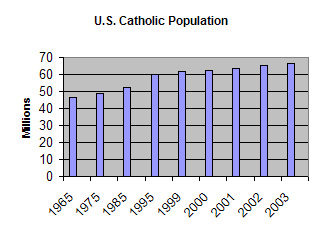 Many people, such as the media, who comment on the number or percentages of Catholics assume a Protestant model of church membership: someone is considered a member when he/she is officially registered in a parish. This emphasis upon registration within our culture is taken for granted. After all, people register for the social security system, drivers’ licenses, library cards, fraternal organizations and, other religious denominations. Why not assume the same with the Catholic Church?
Many people, such as the media, who comment on the number or percentages of Catholics assume a Protestant model of church membership: someone is considered a member when he/she is officially registered in a parish. This emphasis upon registration within our culture is taken for granted. After all, people register for the social security system, drivers’ licenses, library cards, fraternal organizations and, other religious denominations. Why not assume the same with the Catholic Church?
The Catholic Church is governed by its internal church regulations, the Code of Canon Law. This Code makes no references to people needing to register in a parish to be counted as Catholic. While registration may make good sense from an administrative point of view, this goes beyond any requirement of Church Law. The Code implies that a person is considered a Catholic if he/she is baptized a Catholic and does not formally repudiate his/her faith.
The Catholic Research Forum Method
An alternative method of estimating Catholics was developed in the 1980s by the Catholic Research Forum, a group of researchers interested in applying analytical solutions to real-life diocesan issues. After consulting with canon lawyers and demographers from the US Census Bureau, they developed a method based upon sacramental data that dioceses regularly collect – infant baptisms and funerals. This method was endorsed in 1988 by the Bishops’ Committee on Research and Practices. Dioceses are not required, however, to use this method and it is unclear how many do so today.
The methodology needs three secular data items for each county: live births; deaths; and total population. This information is annually available online at state data centers. Using these data and the sacramental data it is simple to compute the percentage of infants that receive Catholic baptism. Likewise one computes the percentage of people who die who receive Catholic funerals. These percentages are averaged to get the Catholic percentage for each county for any one year. To smooth out random year-to-year variations, it is desirable to use a three-year moving average. This final Catholic percentage is multiplied by the total population to arrive at an estimate of the Catholic population. Calculations and reporting is often done at the diocesan level.
The major strength of this methodology is that it is systematic. This is the very basis of good research and can hardly be minimized. The methodology is also relatively simple to understand and to use. Another strength is that it brings the Catholic Church’s practice in harmony with its self-understanding, as seen in Canon Law.
The single greatest weakness lays in the fact that measurements only are taken at two points of a person’s life: birth and death. On these two points the entire methodology pivots and is balanced. Any anomaly which causes an overcount or undercount in either baptisms or funerals may lead to a considerable error in the final estimate. This may happen, for example, if large numbers of people from outside a particular diocese have their babies baptized in this diocese. This will inflate the Catholic percentage.
Another challenge for the methodology is migration. For example, a diocese in Florida may find large numbers of Catholics from the north moving to it for retirement. This increase in the Catholic population should eventually manifest itself in an increase in Catholic funerals. But if a significant percentage of the older Catholics who die in Florida are buried elsewhere, the methodology will underestimate the Catholic population.
The burden lies with the local researcher to catch these anomalies and adjust the final counts.
Next time: The Official Catholic Directory and telephone polls compared to the Catholic Research Forum method

Parish data is a different story all together. If an adult child is still at his home parish he will often assume that he is understood as a parishioner even if he hasn’t registered. Records are purged systematically as need be, though it doesn’t work as efficiently as one would hope.
This does, however, explain a lot about how a diocese with several huge parishes could still be only “7-8% Catholic” when it’s clear that some areas may have changed the demographics. I’m thinking here about the Diocese of Lafayette-in-Indiana because one deanery has had huge numbers of people moving from Indianapolis to Hamilton and Boone Counties.